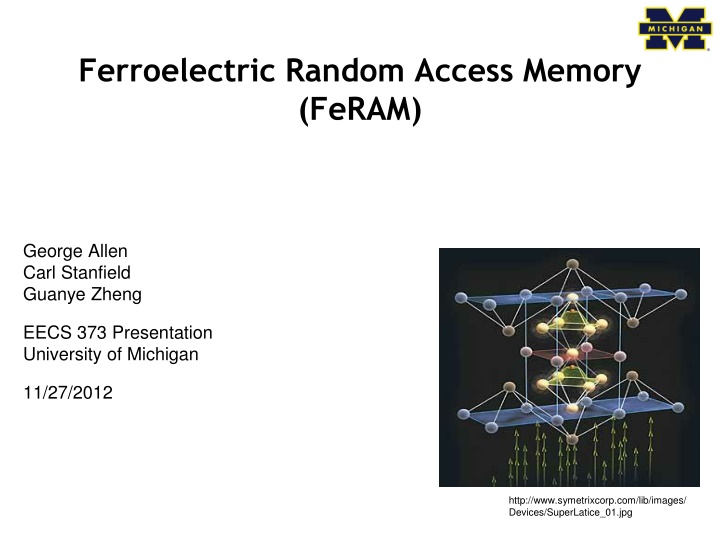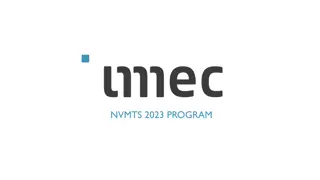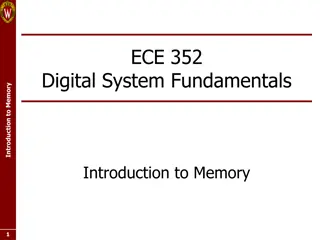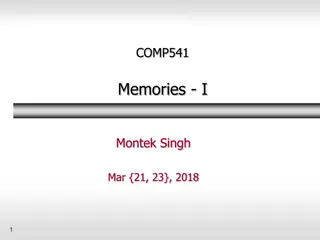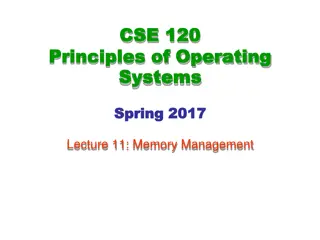Overview of Ferroelectric Random Access Memory
Ferroelectric Random Access Memory (FeRAM) is a non-volatile memory technology that offers fast read/write speeds, high endurance, and low power consumption. This memory type, first introduced in 1952, has unique properties that differentiate it from traditional DDR and other memory technologies. FeRAM operates based on the reorientation of atoms to store data, providing both volatile and non-volatile storage capabilities. Comparison with other memory types like EEPROM showcases FeRAM's advantages in terms of write time, energy efficiency, and power consumption. Explore the history, operational processes, and benefits of FeRAM in this insightful overview.
Download Presentation

Please find below an Image/Link to download the presentation.
The content on the website is provided AS IS for your information and personal use only. It may not be sold, licensed, or shared on other websites without obtaining consent from the author.If you encounter any issues during the download, it is possible that the publisher has removed the file from their server.
You are allowed to download the files provided on this website for personal or commercial use, subject to the condition that they are used lawfully. All files are the property of their respective owners.
The content on the website is provided AS IS for your information and personal use only. It may not be sold, licensed, or shared on other websites without obtaining consent from the author.
E N D
Presentation Transcript
Ferroelectric Random Access Memory (FeRAM) George Allen Carl Stanfield Guanye Zheng EECS 373 Presentation University of Michigan 11/27/2012 http://www.symetrixcorp.com/lib/images/ Devices/SuperLatice_01.jpg
History Dudley Allen Buck, graduate thesis, MIT 1952 "Ferroelectrics for Digital Information Storage and Switching" - http://hdl.handle.net/1721.3/40244
Is FeRAM just a fancy version of DDR? DDR FeRAM 1T-1C cell dielectric layer read requires cap refresh volatile <50nm refresh ~65ms 1T-1C cell ferroelectric layer (PZT) read requires cap refresh non-volatile (sorta) 130nm refresh not needed
Read/Write process Read force cell to '0' state reorientation of atoms causes a pulse sent to driveline prior state was '1' - pulse is detected prior state was '0' - pulse not detected refresh state Write charge forces a polarity change write '0' write '1' read wordlin e assert assert assert bitline gnd vdd float drivelin e vdd gnd vdd
Why FRAM? Rough Comparison (1st generation) source: TI's presentation on FRAM
More Detailed / Overall Memory Products Comparison source:http://www.fujitsu.com/emea/services/microelectronics/fram/technology/
Memory Product Comparison On Power and Size source: presentation (titled Novel Memory Architectures) by Insoo Kim / Feng Wang, The Penn State Universitym on Mar. 23th, 2005
FRAM vs EEPROM 1/30,000 Write Time 1/20 Energy -- 1/400 Power source: http://www.fujitsu.com/emea/services/microelectronics/fram/technology/
FRAM vs EEPROM 100,000 Times Better ENDURANCE source: http://www.fujitsu.com/emea/services/microelectronics/fram/technology/
FRAM vs FLASH Less Power and Faster Speed source: http://www.ti.com.cn/mcu/cn/docs/mcuproductcontentnp.tsp?familyId=1751§ionId=95&t abId=2840&family=mcu
FRAM vs FLASH Much Better Endurance source: http://www.ti.com.cn/mcu/cn/docs/mcuproductcontentnp.tsp?familyId=1751§ionId=95&t abId=2840&family=mcu
FRAM vs SRAM SRAM is better at: Price & Speed(not that much) FRAM is more Flexible (all-in-one memories) source: http://www.ti.com.cn/mcu/cn/docs/mcuproductcontentnp.ts p?familyId=1751§ionId=95&tabId=2840&family=mcu
FRAM vs DRAM When density and price are most important (for example, memories for pixels) DRAM is best choice FRAM cannot replace DRAM yet
FRAM getting better at density! Currently: up to 4Mbits (according to TI's data) Not as good as DRAM and SRAM Better than EEPROM and FLASH Expected: As good as DRAM
Take-away Point: FRAM combines Advantages! source: http://www.ti.com.cn/mcu/cn/docs/mcuproductcontentnp.tsp?familyId=1751§ionId=95&t abId=2840&family=mcu
Application Benefits Low Power Consumption Good For: Low energy access systems Reason: Write cycles require less power (RFID) Fast Write Speed Good For: High noise environment Reason: Short write time limits window of vulnerability High Endurance Good For: Diagnostic and maintenance systems Reason: No restriction of system state writes Misc Resistant to Gamma Radiation (70kGray) unlike EEPROM AEC-Grade 1 adder cheaper than other nonvolatile memory
Application Drawbacks Low Storage Density Bad For: Storing large amounts of data Reason: Poor density compared to DRAM & SRAM Higher Cost
Current Applications Automotive Shift-by-Wire/Navigation/Anti-Pinch Control Computing Solid State Drive/LAN Bypass/Network Router o o http://www.ramtron.com/applications/computing.aspx
Current Applications Metering Advanced Metering/Gaming/POS Systems Industrial o Motion Control/Process Controls RFID/Wireless Memory Wireless Datalogging/Gamma Radiation o http://www.ramtron.com/applications/metering.aspx o
The Future of FRAM Improved Storage Density Stacking 3D integration Improved Manufacturing Process Conventional process degrades ferroelectric layer Reduction in Size Unknown charge density detection limit Theoretical performance unclear
